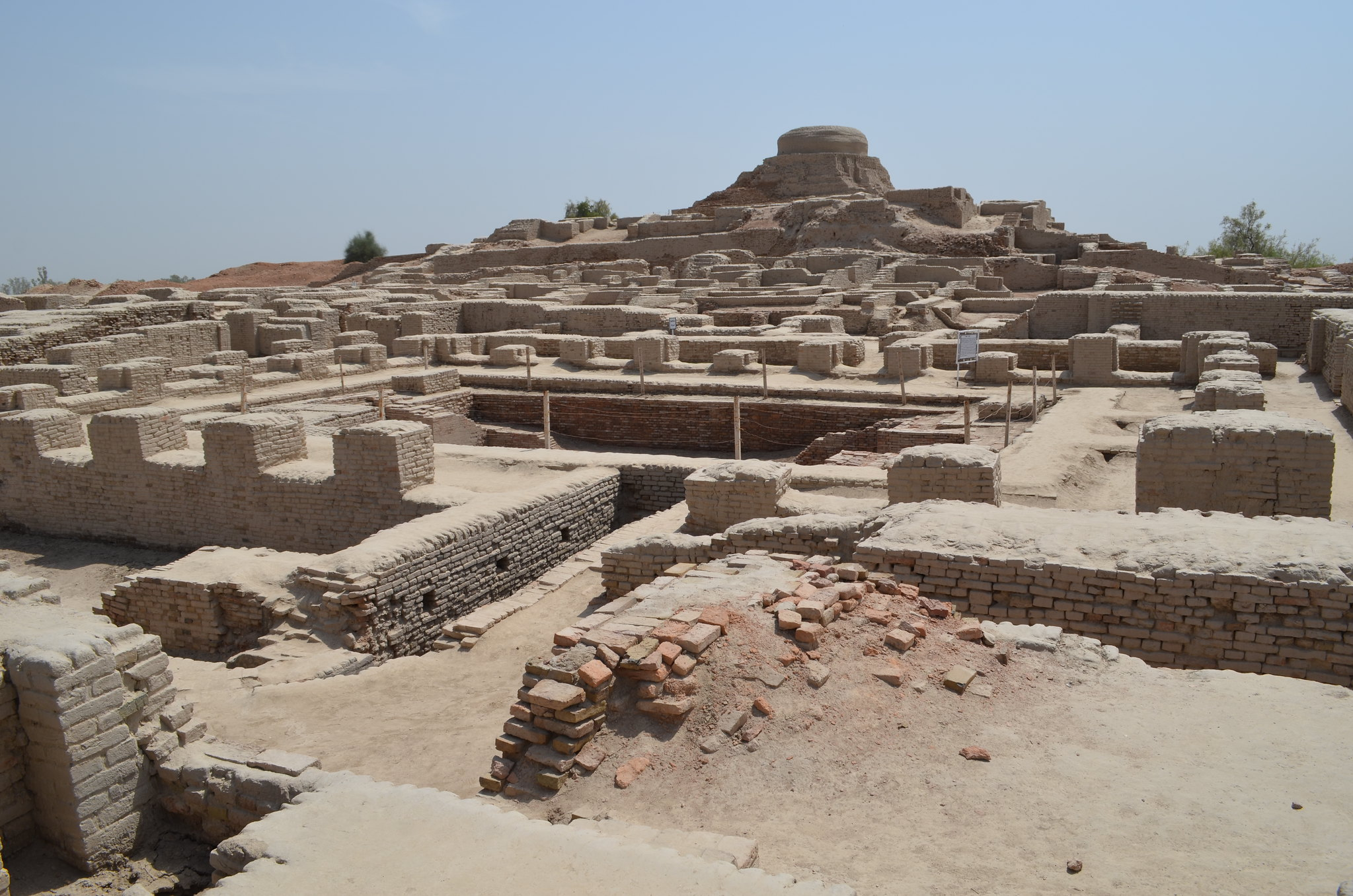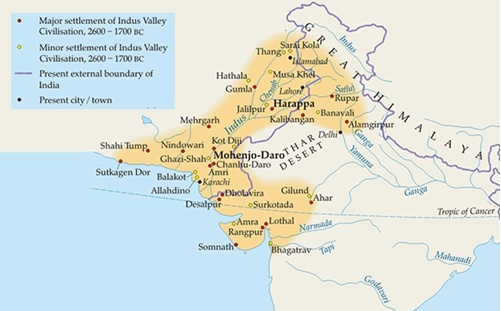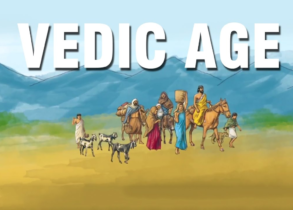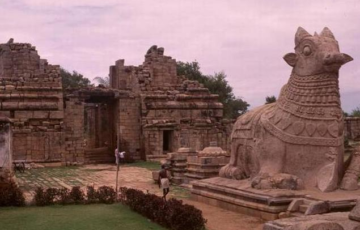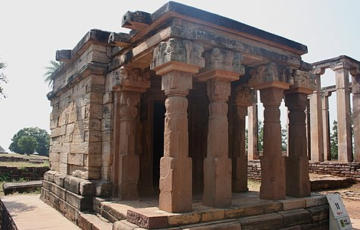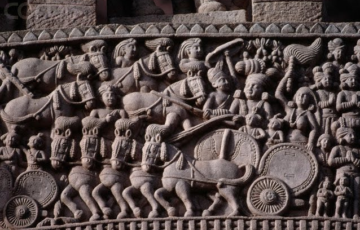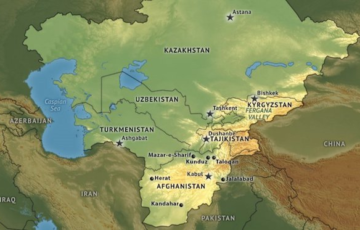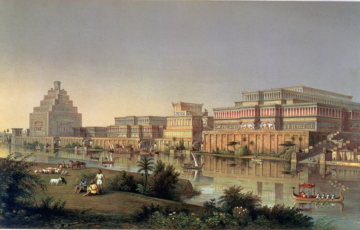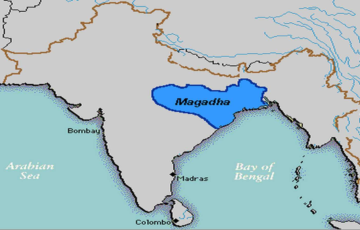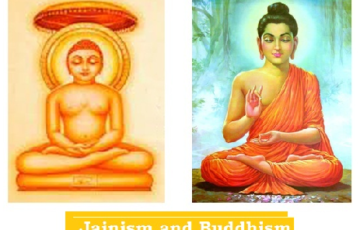INDUS VALLEY CIVILIZATION
Introduction
The Indus Valley Civilization, or the Harappan Culture, appeared in the northwestern part of India and Pakistan in the third millennium BC and represents the first phase of urbanization in India.
| Phases | Features |
| Early Harappan or Regionalisation (3300-2600 BC) | Fortification, grid planning, development of incipient trade network and craft specialization |
| Transitional Phase | Increasing craft specialization, organized irrigation system, partly standardized pottery designs |
| Mature Harappan or Integration (2600-1800 BC) | Full-scale urbanization, emergence of writing, uniformity in artifacts, full-fledged trade |
| Late Harappan or Localisation (Post 1800-1300 BC) | Decline and abandonment of some sites, rise of pastoral mode |
Polity
- Central authority likely helped create similar cultures in pottery, seals, weights, bricks, script, and labor organization across Harappan sites.
- Some archaeologists believe that there weren’t specific rulers, and everyone had equal status in Harappan society.
- Other scholars suggest that while there might not have been a single ruler, there were possibly multiple rulers, with Mohenjodaro having its ruler, Harappa another, and so on.
- Merchants could have been among the ruling class, rather than priests, unlike in the cities of lower Mesopotamia.
TOWN PLANNING AND STRUCTURES
In ancient Egypt, buildings typically used dried bricks for construction, while baked bricks were more common in Mesopotamia. However, the Harappan cities extensively used baked bricks compared to both Egypt and Mesopotamia.
- Cities were often split into two sections:
- Lower Part: Where common people lived and worked.
- Citadel or Raised Part: A smaller area, which housed important buildings like granaries, workshops, and public structures.
- The drainage system in Harappan cities was quite sophisticated – every house was linked to street drains. These drains consisted of main channels constructed from bricks set in mortar, covered with removable bricks or mortar for cleaning purposes.
| Lower Towns | Citadel |
| ● City planning followed a grid pattern, with streets intersecting at right angles.
● Streets were constructed first, and then houses were built along them. ● Burnt bricks and stones were used for construction. ● Houses were made of mud bricks, while drainage systems were built using burnt bricks. ● Bricks used across all Harappan structures had a consistent 1:2:4 ratio in terms of thickness, width, and length. ● Houses had bathrooms paved with burnt bricks and efficient drainage systems. ● Houses varied in size and could have two or more stories with multiple rooms, but they were quite similar in appearance. ● Many houses featured a central courtyard surrounded by rooms, which served as the focal point for various activities like cooking and weaving. |
● The citadel was built on a mud-brick platform and separated from the Lower Town by a wall.
● It likely housed members of the ruling class. ● Great Bath ○ The Great Bath at Mohenjo-daro was used for special rituals. ○ It was a large rectangular tank surrounded by a corridor on all sides. ○ The floor was made of burnt bricks and there were changing rooms nearby. ○ The bricks were sealed tightly with gypsum mortar. ● Granaries ○ They were significant structures in Harappan sites. ○ The Great Granary in Mohenjo-daro was the largest building, ○ while Harappa had six granaries in its citadel. ○ Circular brick platforms were likely used for threshing grains, as wheat and barley remnants have been found in their crevices. |
Faith and Belief System
- The Harappan civilization was not focused solely on religion; it had a secular character.
- Temples were not discovered in the archaeological findings, but worship was inferred from statues and figurines.
- The Harappans viewed the Earth as a fertility goddess, indicated by a plant growing from the embryo of a woman in one of the terracotta figurines.
- A seal depicts a male deity in a yogi’s sitting posture with three heads and horns, surrounded by elephants, tigers, rhinoceros, and buffalo. This image is reminiscent of ‘Pasupati Mahadeva’ (Proto-Shiva).
- Religious practices in the Harappan civilization included worship of the Yoni, Phallic (lingam) worship, animal worship (zoolatry), use of fire altars, and reverence for the pipal tree.
- Many amulets have been discovered, likely used to protect against ghosts and evil spirits.
HARAPPAN SCRIPT
- The oldest script in the Indian subcontinent is written from right to left.
- This script remains undeciphered, and it doesn’t seem to be related to scripts from West Asia.
- Unlike alphabetical scripts where each sign represents a vowel or consonant, this script contains numerous pictographs, estimated to be between 250 and 400 in number.
Weights and Measures
- Weights were often made of chert stone and were square-shaped without any markings.
- The units of weight were in multiples of 16, such as 16, 64, 160, 320, and 640.
- The tradition of using multiples of 16 continues in India, where 16 annas make up one rupee.
- They used a binary numbering system, which means they counted in doubles: 1, 2, 4, 8, 16, 32, and so on.
- For measuring, they used sticks with marks indicating measurements; one such stick was made of bronze.
SOCIAL CHARACTERISTICS
- Harappan society was mostly urban and consisted mainly of the middle class.
- The society had three main social groups:
- Rulers
- Wealthy merchants
- Poor laborers who lived in the lower parts of the city.
| Burial Practices | ● Burials at Harappan sites included fire altars, indicating cremation rituals and elaborate burial practices, suggesting a belief in the afterlife.
● Burial items such as pottery, ornaments, jewelry, copper mirrors, and beads indicated a belief in an afterlife. |
| Lifestyle | ● Both men and women were buried with jewelry.
● Men and women wore different clothing, with men wearing dhotis and shawls. ● Cinnabar was used as a cosmetic, and they used face paint, lipstick, and eyeliner. |
| Artefacts | ● Valuable artifacts were mainly found in larger settlements like Mohenjo Daro and Harappa, rather than smaller settlements.
○ Like the Miniature pots of faience, perhaps used as perfume bottles ● Gold jewelry found at Harappan sites was usually discovered in hoards. |
Agriculture
The agricultural surplus was an important stimulus for a number of developments.
- Terracotta models of ploughs found at Cholistan and Banawali.
- At Kalibangan, fields showed two sets of furrows at right angles, indicating a double cropping system.
- Bull representations on seals and terracotta sculptures suggest their use in ploughing.
- Crops
- Wheat, barley, lentils, chickpeas, sesame, mustard, and millets.
- Used animal-drawn wooden ploughs and stone sickles.
- Rice cultivation was found in Lothal and Rangpur (Gujarat).
- IRRIGATION: Utilized canal and well irrigation
Peasants paid taxes in cereals, which were stored in granaries for wages and emergencies, similar to practices in Mesopotamia.
Animal Domestication
Harappans practiced pastoralism, which means they raised animals.
- The Harappan cattle, known as Zebu, were a large breed and often depicted on their seals.
- They domesticated various animals: oxen, buffaloes, goats, sheep, fowl (birds), pigs, dogs, cats, asses (donkeys), and camels.
- Humped bulls were particularly favored among the domesticated animals.
- Fish and birds were part of their diet.
- Archaeological evidence indicates the presence of boar, deer, and gharial (a type of crocodile).
- Horses were not known to the Harappans.
- They were aware of elephants and rhinoceros (from Amri), but lions were unknown to them.
Trade and Exchange
- Harappan seals and materials found in Sumerian and Mesopotamian sites.
- Harappans imitated cosmetics from Mesopotamia.
- Cuneiform inscriptions: It mentions trade between Mesopotamia and Harappans and refers to “Meluha” as the Indus region.
- Intermediate trading stations included Dilmun (Bahrain) and Makan (Makran coast).
- Means of Transport:
- Bullock carts and boats were used.
- Discovery of a dockyard in Lothal suggests long-distance trade.
- Carts had solid wheels, similar to modern horse carriages (ekka).
- Trade Methods:
- Barter system was used.
- No metallic money circulated.
- Trade Routes:
- Harappans traded with the Khetri region of Rajasthan for copper and with South India for gold.
- They engaged in barter exchange with civilizations like Sumer (southern Iraq) and Mesopotamia (present-day Iraq, Syria, Turkey).
Imports and exports of Harappa
Barter trade occurred with civilizations such as Sumer (located in southern Iraq, extending from around Baghdad to the Persian Gulf) and Mesopotamia (situated in present-day eastern Syria, southeastern Turkey, and most of Iraq, encompassing the land between the Euphrates and Tigris rivers).
- Exported Goods: Agricultural Products, Cotton Goods, Ivory Products, Terracotta Figurines from various Harappan Cities, Beads from Chanhudaro, Conch Shells from Lothal.
| Imported Goods | Sources | Imported Goods | Sources |
| Gold | Afghanistan, Iran, Kolar (Karanataka) | Lapis Lazuli | Shortughai (Afghanistan) |
| Bitumen | Balochistan, Mesopotamia | Jade | Pamir |
| Copper | Khetri (Rajasthan), Oman | Turquoise | Iran |
| Tin | Afghanistan, Iran | Steatite | Tapi Chahya (Iran) |
| Lead | South India |
CRAFTSMANSHIP
Different Harappan sites were known for specializing in the production of specific craft materials.
| Craft Material | Specialized Site(s) |
| Shell | Nageshwar and Balakot |
| Lapis Lazuli | Shortughai |
| Carnelian | Lothal |
| Steatite | South Rajasthan |
| Copper | Rajasthan and Oman |
Harappans were skilled in various crafts such as metal casting, boat-making, stone carving, pottery, and terracotta sculpture.
- Stone, bronze, and terracotta sculptures were discovered, including a red sandstone torso from Harappa and a soapstone bust from Mohenjodaro.
- Terracotta sculptures were less refined compared to stone and bronze, but they displayed realistic features, especially in Gujarat and Kalibangan.
- Notably, a mother goddess terracotta figure was found in Harappa.
| Seals | ● Seals were primarily made of steatite and occasionally of other materials.
● They featured various figures such as the Pashupati Seal: Unicorn bull, Rhinoceros, Tiger, Elephant, Bison, Goat, Buffalo ● These seals might have indicated ownership of transported goods. |
| Pottery | ● Pottery was mostly wheel-made, with few hand-made pieces.
● Plain pottery made of red clay was more common than painted ware. ● Pottery was well-fired with a deep red slip and black paintings. ● Motifs on pottery included pipal leaves, fish-scale designs, intersecting circles, zigzag lines, horizontal bands, and geometrical patterns with floral and faunal elements. |
Textiles and Ornaments
- People in the Indus Valley Civilization knew about cotton and silk.
- A figure believed to be a priest is shown wearing a shawl-like cloth with flower patterns.
- Spinning cotton and wool was common.
- Beads and ornaments were crafted from materials like carnelian, jasper, crystal, steatite, as well as metals such as copper, bronze, and gold. They also used shell, faience, terracotta, and burnt clay.
- Note-The red color of carnelian beads came from firing yellowish raw material (Chalcedony) at various stages of production.
- Mesopotamian excavation sites have revealed similar artifacts, indicating trade with the Indus Valley.
- In Farmana (Haryana), a cemetery was found with buried bodies adorned with ornaments.
Metal, Tools and Weapon
- The Harappan civilization existed during the Bronze Age and were skilled in crafting tools from copper bronze, made by blending tin with copper.
- Tools:
- Harappans utilized various materials including chert blades made from Rohri Chert, copper items, bone, and ivory tools.
- Rohri chert: a fine-grained sedimentary rock found in Pakistan, to create stone blades and tools.
- Copper was used to make tools like points, chisels, needles, fish hooks, razors, weighing pans, mirrors, and antimony rods.
- Harappans utilized various materials including chert blades made from Rohri Chert, copper items, bone, and ivory tools.
- Harappans armed themselves with weapons such as arrowheads, spearheads, celts, and axes.
- Bronze Casting was a widespread practice among the Harappans, employing the ‘lost wax’ or Cire Perdue technique.
- Famous examples of Harappan bronze craftsmanship include the Dancing Girl statue from Mohenjo-daro and the Bronze figure of a bull from Kalibangan.
- The Harappans did not possess knowledge of ironworking.
IMPORTANT SITES AND FEATURES – at a glance
| Site | Features |
| Harappa | ● Harappa was first visited by Charles Mason in 1826
● Discovered by Daya Ram Sahni in 1921 ● First archaeological site of the Indus Valley civilization, giving the civilization its name. ● Location-Punjab (Pakistan) ● River- Ravi ● Two rows of six Granaries, ● Male torso (Red sandstone), Stone symbols of lingam and Yoni, Mother Goddess and Dice. |
| Mohenjo-daro | ● Discovered by R. D. Banerji in 1922
● Location-Sindh (Pakistan) ● River-Indus ● Largest site of the Indus Valley civilization. ● Post-cremation burial, Great Granary, Great Bath (largest building), Seal with Pashupathi and mother goddess, Bronze statue of the dancing girl, Bronze buffalo, bearded man. ● Planned town built on a platform, with distinct citadel and lower town areas. |
| Chanhu-daro | ● Discovered by N. G. Majumdar in 1931
● Location-Sindh (Pakistan) ● River-Indus ● Devoted to craft production, including bead-making, shell-cutting, metalworking, seal-making, and weight-making ● Dog’s paw imprint on brick, ● Terracotta model of bullock cart, Bronze toy cart. |
| Lothal | ● Discovered by S. R. Rao in 1954
● Location-Gujarat ● River- Confluence of Bhogava and Sabarmati ● Important naval trade site with Port and Dockyard. – ● Granaries, Rice husk, Double burial (male and female together). – ● Citadel not walled off but built at a height. ● Fortified settlement with internal walls. |
| Dholavira | ● By J. P. Joshi in 1967
● Location-Gujarat ● River-Luni ● UNESCO World Heritage Site. ● Unique water harvesting and stormwater drainage system. – ● Megalithic stone circle, specialized drill, giant water reservoirs. ● Stone used in construction. ● Site divided into Citadel, Middle town, and Lower town. ● Fortified settlement with internal walls. |
| Surkotada | ● Location-Gujarat
● Oval grave, Pot burials. ● Bones of horse |
| Kalibangan | ● By B. B. Lal in 1953
● Location-Rajasthan ● River-Luni ● Bangle factory, ● Ploughed field surface ● Camel bones ● Fire altars and Bronze figure of a bull. |
| Kot-Diji | ● LocationSindh (Pakistan)
● River-Sindh ● Fortification made of mud bricks and stone. ● Wellfired red and buff wares pottery with common motifs like horned deity, pipal leaves, and fish scales executed in black. |
| Amri | ● Location-Sindh (Pakistan)
● River-Sindh ● Transitional culture between pre and post-Harappan culture ● Actual remains of rhinoceros. |
| Suktagendor | ● Location-Sindh (Pakistan)
● River-Dasht River ● Originally a port later cut off from sea due to coastal upliftment; ● had trade links with Babylon. |
| Rangpur | ● Location-Gujarat
● River-Madar ● Remains of both pre-Harappan and mature Harappan culture. ● Yellow and grey colour pots of pre-Harappan people. |
| Banawali | ● Location-Haryana
● River-Rangoi ● – Centre of Pre-Harappan, Mature, and Late Harappan civilization. – ● Oval-shaped settlement, Barley grains, Lapis Lazuli (blue gem), Fire altars. ● Lack of systematic drainage ● only a city with Radial streets. |
| Ropar | ● Location-Punjab
● River-Sutlej ● First site excavated after independence. – ● Dog buried with human; ● oval pit burials. ● Copper axe found. |
| Rakhigarhi | ● By Amarendra Nath in 1996
● Location-Haryana ● Largest Indian site of the Indus Valley Civilization. ● Shows all three phases of Harappa Culture. |
Geographical Area and the Settlements
| Direction | Location |
| Northern most | Shortugai (Afghanistan) |
| Western most | Sutkagendor on the Pakistan-Iran border |
| Eastern most | Alamgirpur (Uttar Pradesh, India) |
| Southern most | Daimabad (Maharashtra, India) |
Authorship and the Making of Indian Culture
- Some believe that the creators of the Harappan Civilization were the priest-kings who spoke Dravidian languages.
- Archaeological findings suggest that after the decline of the Harappan Civilization, its people moved towards the eastern and southern regions of India.
- It’s possible that some Harappan individuals settled in various parts of India. However, we can only confirm this once we decipher the Harappan script.
Contemporary Cultures of the Indus Civilisation
- The Indus region was home to various groups like pastoralists, farmers, and hunter-gatherers.
- Villages and large towns existed in the Indus region, with a mixed population.
- Across India, from Kanyakumari to Kashmir and Gujarat to Arunachal Pradesh, diverse communities of hunter-gatherers, pastoralists, and farmers likely lived during this period.
- Understanding the history of these groups is crucial as their cultural and ecological knowledge contributed to Indian culture.
- While the Indus Civilization thrived in northwestern India, different cultures were emerging in other parts.
- In southern India, particularly Kerala and Sri Lanka, hunting and gathering were prevalent.
- Although the Harappans had watercraft knowledge, evidence of their connections with South India remains unclear.
- Northern South India, like Karnataka and Andhra, had Neolithic cultures focused on pastoralism and agriculture.
- Chalcolithic cultures were common in the Deccan and western India, while Neolithic cultures dominated northern India, including Kashmir, the Ganges valley, and central and eastern regions.
- India during the time of the Harappans was a diverse cultural mosaic.
Reasons of Decline of Indus Valley Civilization
The Indus Valley Civilization started declining around 1900 BCE.
- Historians attribute the decline to changes in climate, reduced trade with Mesopotamia, and drying of the river and water sources due to prolonged drought.
- Invasions, floods, and changes in the course of the river are also seen as contributing factors to the downfall of the Indus civilization.
- Over time, population migration towards the south and east from the Indus region.
UPSC PREVIOUS YEAR QUESTIONS
1. Which one of the following ancient towns is well-known for its elaborate system of water harvesting and management by building a series of dams and channelizing water into connected reservoirs? [UPSC CSE 2021]
1. Dholavira
2. Kalibangan
3. Rakhigarhi
4. Ropar
2. Regarding the IVC consider the following statements : [UPSC CSE 2011]
1. It was predominantly a secular civilization and the Religious element, though present did not dominate the scene
2. During the period, cotton was used for manufacturing textiles.
Which of the statements given above is/are correct?
a) 1 only
b) 2 only
c) Both 1 and 2
d) Neither 1 nor 2
3. Which one of the following characterises the people of the Indus Valley Civilization ?
1) They possessed great palaces and temples
2) They worshiped both male and female deities.
3) They employed horse drawn chariots in warfare
Select the correct code given below : [UPSC CSE 2013]
a) 1 and 2 only
b) 2 only
c) 1, 2 and 3
d) None
4. Which one of the following is not a Harappan Site? [UPSC CSE 2019]
1. Chanhudaro
2. Kot Diji
3. Sohgaura
4. Desalpur
Answers:
1. 2
2. 1
3. 4
4. 3
Sohgaura village in Gorakhpur district of Uttar Pradesh has a copper plate inscription from the Mauryan period, providing information about storehouses. Chanhudaro, Kot Diji, and Desalpur are Harappan sites, with Chanhudaro and Kot Diji in Sindh province, Pakistan, and Desalpur in Kutchh region, Gujarat.
| IMPORTANT FACTS RELATED TO THE CHAPTER
● The knowledge of script and town planning in the Indus Valley Civilization surpassed that of the Pre-Aryans. ○ Harappan pottery was red with black figures, while Aryans used grey painted pottery. ● The culture of the Indus Valley Civilization differed from Vedic culture in several aspects: urban vs. rural, depictive script vs. Vedic script, lack of iron usage vs. extensive iron weapon use by Aryans. ● The first artifact discovered in Harappa was a stone seal carved with a unicorn and inscription, indicating a developed culture. ● Harappans were known to use silver obtained from mines in Zawar, Ajmer (Rajasthan), Afghanistan, and Iran. ● Mehrgarh, a Neolithic site in Balochistan, Pakistan, is considered a precursor to the Indus Valley Civilization, displaying the transition from early settlement to mature Harappan civilization. ● Harappan pottery was bright or dark red and well-baked, consisting of plain and painted wheel-made wares. ○ Polychrome pottery was rare, mainly comprising small vases with geometric patterns. ● The Great Bath at Mohenjo-daro is a well-known structure, measuring 55m x 33m, with a central pond measuring 11.8m x 7.04m and a maximum depth of 2.43m. ● The Indus Valley Civilization was a Bronze Age civilization. They had an advanced drainage system covered with slabs, and evidence of both internal and external trade indicates an advanced stage of trade and commerce. ○ It yielded evidence of gold, silver, copper, and brass. Iron was not known to the people of Harappa, and the Iron Age in India is considered to have begun around the later Vedic period, approximately 1000 B.C. ● Kalibangan provided evidence of ploughed agricultural fields and business activities. It was excavated by A. Ghosh in 1951, revealing a fortified enclosure with rectangular salients and towns. ● Rakhigarhi village, situated in Hisar district of Haryana along the bank of the Ghaggar-Hakra river, was discovered by Surajbhan in 1969. ● Chanhudaro was discovered by N.G. Majumdar in 1931 and excavated by E.J.H. Mackay in 1935-36, revealing a bead-making factory and furnace. ● Rangpur, located in the Saurashtra region of Gujarat, cultivated rice, bajra, and millet based on vegetative remains found. ● Dadheri, an excavation site in Govindgarh district of Ludhiana (Punjab), is known for its painted grey ware culture associated with the arrival of the Aryans. ● Lothal, discovered by S.R. Rao in 1954, is situated near the village of Saragwala in the Dholka Taluka of Ahmedabad district, Gujarat. It used burnt bricks in the construction of drainage. ● Dholavira, the second largest site of the Harappan Civilization in India after Rakhigarhi, is situated in the Rann of Kutch, Gujarat. ○ The site was excavated by R.S. Bisht and colleagues in 1992. ○ It is notable for its Great Bath and a massive rock-cut reservoir, measuring 80.4 meters in length, 12 meters in width, and 7.5 meters in depth, showcasing advanced water management techniques. ○ The people of Dholavira utilized dams to store water in this reservoir from the earliest evidence. ● Sonauli, an archaeological site in Baraut Tehsil, Baghpat district, Uttar Pradesh, yielded 125 graves belonging to the Indus Valley Civilization. ○ The graves are oriented in a North-South direction, with most identified as primary human burials. ○ Some burials contained animal bones, gold, copper, and bangles. ● No temple or place of worship has been discovered in excavations of the Indus Valley Civilization. ○ Religious artifacts such as mud and stone statues and seals have been found, depicting worship of female deities, Shiva or Pashupati, and animals like snakes, elephants, among others. ○ Worship of plants, trees, or inanimate objects resembling ‘Linga’ or ‘Yoni’ symbols was prevalent during this period. ● Although people of the Harappan Civilization were familiar with horses, no evidence of horses has been found on seals. ○ The majority of seals discovered in the Indus Valley Civilization depict short inscriptions alongside images of animals such as the one-horned bull, buffalo, tiger, rhinoceros, goat, and elephant. ● According to reports from IIT Kharagpur, the decline of the Indus Valley Civilization was attributed to continuous low or negligible rainfall over 900 years, leading to drought conditions. ● The Sumerian Civilization pioneered the development of writing as a formal system. Their primary script, known as cuneiform, is considered one of the earliest writing systems. ● Sir John Marshall, Director-General of the Archaeological Survey of India from 1902 to 1928, identified a figure from the Harappa excavation as an early form of the Hindu god Shiva or Pashupati. ○ The Pashupati seal, depicting a three-faced male deity seated in a yogic posture surrounded by various animals, led historians to conclude that the people of that era worshipped Lord Shiva or Pashupati. ○ Additionally, cylindrical stones found at the site indicated worship of the Lingam, a symbol of Lord Shiva. ● Banawali, an archaeological site in the Fatehabad district of Haryana, belongs to the Indus Valley Civilization period and is situated in the valley of the Ghaggar and its tributaries. |

